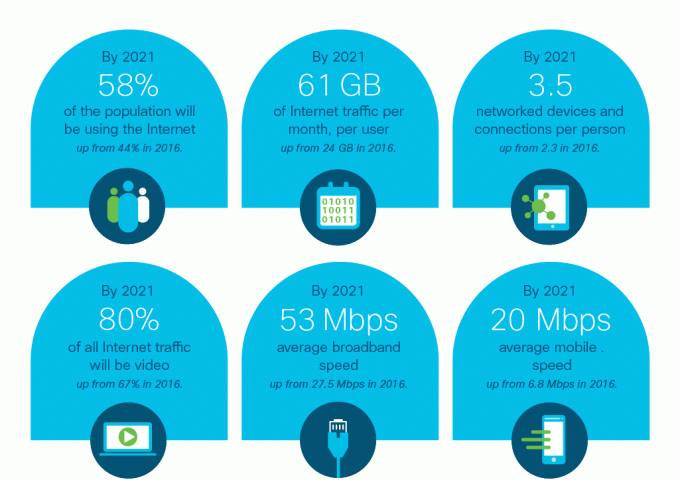The revolution will be televised… over the internet. By 2021, 82 percent of all consumer IP traffic will be video, and that growth will be driven by a boon in live streaming, courtesy of services like Facebook, YouTube and Twitter. In the meantime, the internet will become an even bigger part of the fabric of how we do everything, growing to 3.3 zettabytes of traffic annually by 2021 — up three times compared to internet traffic today (and working out to 278 exabytes per month).
The figures come courtesy of networking giant Cisco, which has just released its annual forecast of internet trends, the Visual Network Index, a 12-year-long project that brings together several independent analyst forecasts with network usage data Cisco gathers from its customers and its own servers.
The bigger picture you get from the report, especially as you read it in conjunction with some of the other marquee crystal ball efforts like Mary Meeker’s internet trends, is one of an increasingly connected world, where ever more activity is moving into the digital ether.
According to Cisco’s calculations, there will be 27 billion devices and connections globally by 2021, with 3.5 networked devices per capita by 2021 — compared to 2.3 networked devices per capita last year (2016). With that increased connectivity — and corresponding growth in network speed and services running on those networks — we will also see a boon in IP traffic, which reached 35 GB per capita in 2016, compared to 13 GB in 2012.
You can look through the bigger report here. Below, some more highlights:

Internet of Things: The trend of connected objects — where previously “dumb,” unconnected physical things can now communicate with us, the network and each other — continues with its quiet but growing presence. Half of the 27 billion connected devices in 2021 will be IoT objects, or 13.7 billion connections. Cisco says that healthcare will be taking the lead on IoT, with growth of 30 percent annually.
Video: The popularity of video is already a major force in our world today, where it accounted for 73 percent of all consumer internet traffic in 2016. That will continue to rise, and will be 82 percent of all consumer internet traffic, up 31 percent, by 2021. One of the bigger drivers here will be live video. This will be 13 percent of internet video traffic by 2021, still lower than other kinds of streamed video, but what’s key here is how it is growing, up 15-fold between 2016 and 2021, representing the biggest growth opportunity for new entrants and creators compared to the long tail of recorded and existing content.
One component of that trend is the switch away from traditional broadcast networks to TV delivered over IP, and the subsequent knock-on effect for traditional pay TV service providers.
Cisco says that the average “cord-cutting” house generates 117 GB per month in internet traffic, versus 63 GB for houses that have internet but also a pay-TV service.
Wi-Fi is the name of the game: Cisco predicts that Wi-Fi will continue to account for the majority of internet traffic, at 53 percent of all access, versus 20 percent for cellular and 27 percent for fixed access. Wi-Fi’s growth, interestingly, is largely unchanged from today: it was at 52 percent of all traffic last year, with the big switch coming in fixed, dropping 11 percentage points and cellular gaining 10 percentage points.
Wi-Fi hotspots and home access points will nevertheless continue to expand, up to 541.6 million by 2021 (up from 94 million last year). Home Wi-Fi will be the vast majority of this figure. China will lead the world in Wi-Fi usage with 170 million access points, followed by the U.S. at 86 million.
DDoS attacks will continue to rise: Cisco also tracks some security metrics in its index and says that the size of DDoS attacks will be “increasing steadily” to approach 1.2 Gpbs by 2012 “enough to take most organizations completely offline” as malicious hackers flood servers and networks with traffic. DDoS attacks can represent up to 18 percent of a country’s internet traffic when they are at their peak.
Currently, DDoS appears to be increasing roughly at the same rate as internet traffic itself, as the sizes respectively grew at 22 percent and 29 percent. The number of DDoS attacks was up by 172 percent last year, and will reach 3.1 million attacks annually worldwide by 2021.
